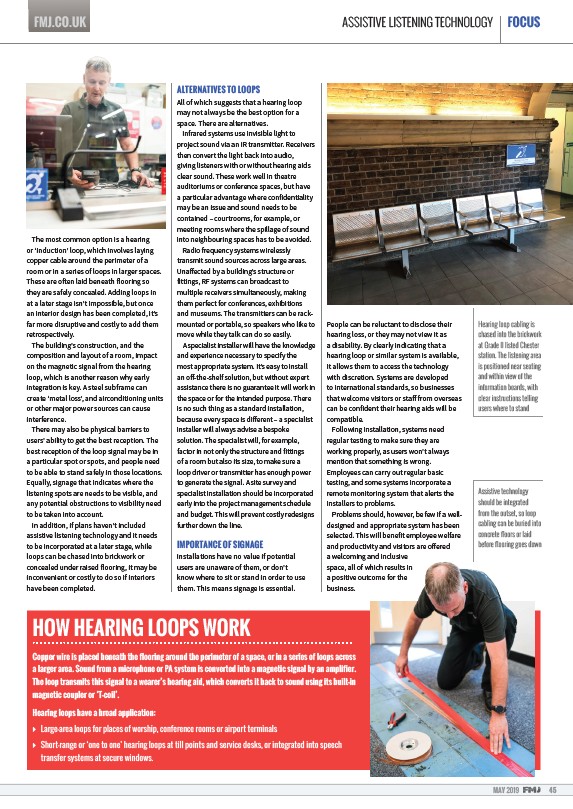
FMJ.CO.UK ASSISTIVE LISTENING TECHNOLOGY FOCUS
MAY 2019 45
The most common option is a hearing
or ‘induction’ loop, which involves laying
copper cable around the perimeter of a
room or in a series of loops in larger spaces.
These are o en laid beneath flooring so
they are safely concealed. Adding loops in
at a later stage isn’t impossible, but once
an interior design has been completed, it’s
far more disruptive and costly to add them
retrospectively.
The building’s construction, and the
composition and layout of a room, impact
on the magnetic signal from the hearing
loop, which is another reason why early
integration is key. A steel subframe can
create ‘metal loss’, and airconditioning units
or other major power sources can cause
interference.
There may also be physical barriers to
users’ ability to get the best reception. The
best reception of the loop signal may be in
a particular spot or spots, and people need
to be able to stand safely in those locations.
Equally, signage that indicates where the
listening spots are needs to be visible, and
any potential obstructions to visibility need
to be taken into account.
In addition, if plans haven’t included
assistive listening technology and it needs
to be incorporated at a later stage, while
loops can be chased into brickwork or
concealed under raised flooring, it may be
inconvenient or costly to do so if interiors
have been completed.
ALTERNATIVES TO LOOPS
All of which suggests that a hearing loop
may not always be the best option for a
space. There are alternatives.
Infrared systems use invisible light to
project sound via an IR transmitter. Receivers
then convert the light back into audio,
giving listeners with or without hearing aids
clear sound. These work well in theatre
auditoriums or conference spaces, but have
a particular advantage where confidentiality
may be an issue and sound needs to be
contained – courtrooms, for example, or
meeting rooms where the spillage of sound
into neighbouring spaces has to be avoided.
Radio frequency systems wirelessly
transmit sound sources across large areas.
Una ected by a building’s structure or
fittings, RF systems can broadcast to
multiple receivers simultaneously, making
them perfect for conferences, exhibitions
and museums. The transmitters can be rackmounted
or portable, so speakers who like to
move while they talk can do so easily.
A specialist installer will have the knowledge
and experience necessary to specify the
most appropriate system. It’s easy to install
an o -the-shelf solution, but without expert
assistance there is no guarantee it will work in
the space or for the intended purpose. There
is no such thing as a standard installation,
because every space is di erent – a specialist
installer will always advise a bespoke
solution. The specialist will, for example,
factor in not only the structure and fittings
of a room but also its size, to make sure a
loop driver or transmitter has enough power
to generate the signal. A site survey and
specialist installation should be incorporated
early into the project management schedule
and budget. This will prevent costly redesigns
further down the line.
IMPORTANCE OF SIGNAGE
Installations have no value if potential
users are unaware of them, or don’t
know where to sit or stand in order to use
them. This means signage is essential.
People can be reluctant to disclose their
hearing loss, or they may not view it as
a disability. By clearly indicating that a
hearing loop or similar system is available,
it allows them to access the technology
with discretion. Systems are developed
to international standards, so businesses
that welcome visitors or sta from overseas
can be confident their hearing aids will be
compatible.
Following installation, systems need
regular testing to make sure they are
working properly, as users won’t always
mention that something is wrong.
Employees can carry out regular basic
testing, and some systems incorporate a
remote monitoring system that alerts the
installers to problems.
Problems should, however, be few if a welldesigned
and appropriate system has been
selected. This will benefit employee welfare
and productivity and visitors are o ered
a welcoming and inclusive
space, all of which results in
a positive outcome for the
business.
HOW HEARING LOOPS WORK
Copper wire is placed beneath the flooring around the perimeter of a space, or in a series of loops across
a larger area. Sound from a microphone or PA system is converted into a magnetic signal by an amplifier.
The loop transmits this signal to a wearer’s hearing aid, which converts it back to sound using its built-in
magnetic coupler or ‘T-coil’.
Hearing loops have a broad application:
Large-area loops for places of worship, conference rooms or airport terminals
Short-range or ‘one to one’ hearing loops at till points and service desks, or integrated into speech
transfer systems at secure windows.
Hearing loop cabling is
chased into the brickwork
at Grade II listed Chester
station. The listening area
is positioned near seating
and within view of the
information boards, with
clear instructions telling
users where to stand
Assistive technology
should be integrated
from the outset, so loop
cabling can be buried into
concrete fl oors or laid
before fl ooring goes down